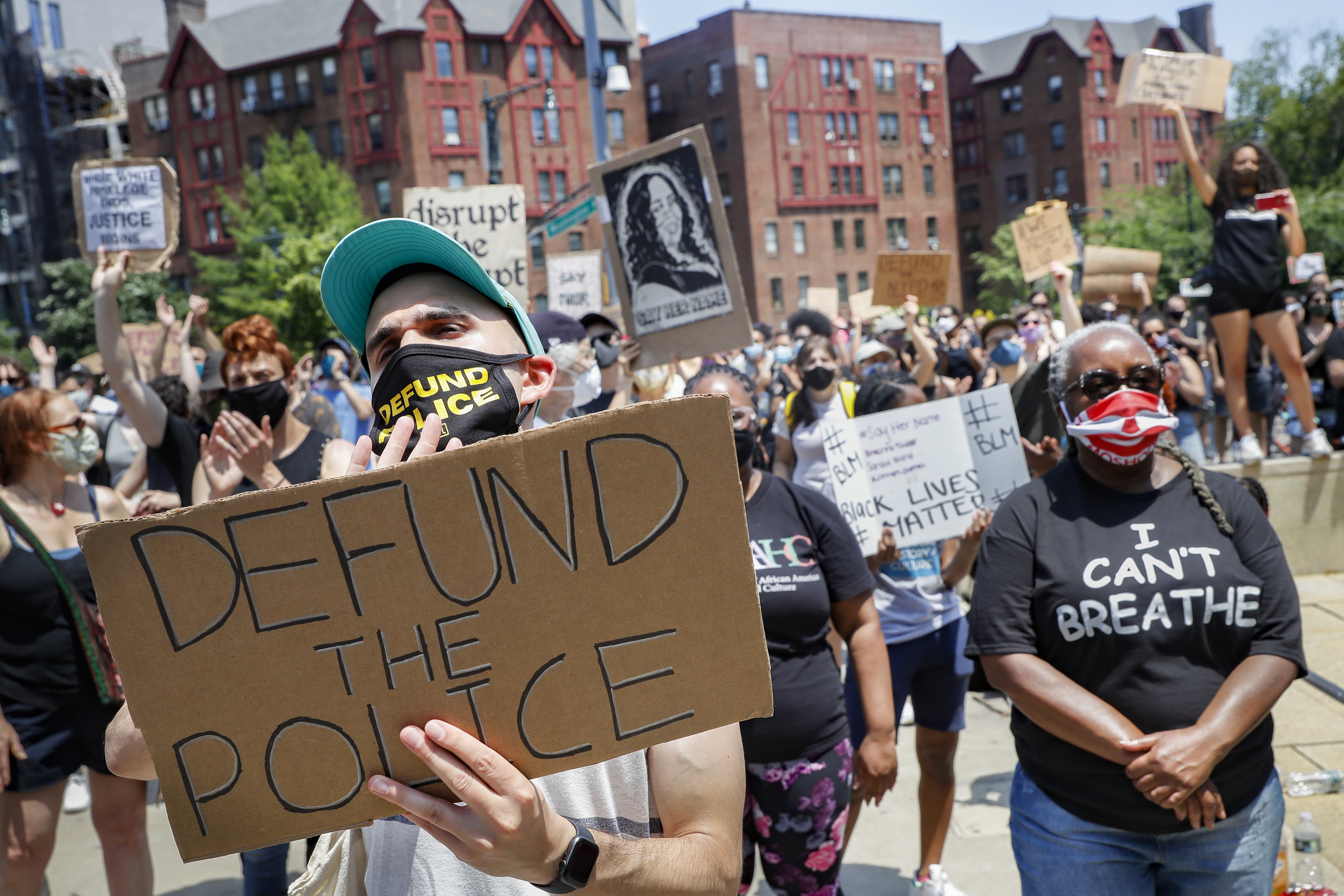In Many Cities, Police Only Solve a Portion of Murder Cases. What Happens if We Defund Them?

National homicide clearance rates have been falling for decades. AP Photo/Matt Rourke
Homicide clearance rates in cities across the country are abysmal. Experts say solving more murders would involve increased resources and improved community relations.
Alonzo Thomas IV was 20 years old when he was killed on April 5, 2014. He was a father of two children, one of them not yet born, when he was shot in Kansas City, Missouri.
“He was a young man who was just trying to figure out life,” said Monique Willis, his mother. “He was very loving.”
Over six years later, no arrests have been made in his case, making him one of thousands of murder victims across the country whose killers have never been brought to justice. Nationally, the homicide clearance rate—the term for the percentage of reported cases that are solved—stands around 62%. Kansas City’s is higher than average at 69%, but local advocacy groups have long complained that the clearance rate could be higher if the police department engaged in more community outreach, particularly in Black neighborhoods, and made trusted connections with potential witnesses.
Despite leaving so many murders unsolved, Kansas City is doing better than many other cities. Homicide clearance rates in 2019 stood at 57% in Memphis, 53% in Chicago, 32% in Baltimore, and all the way down to 20% in southeast Brooklyn.
This failure to solve so many killings—making murder a crime that often comes with no official repercussions—is striking at a time when activists across the country are talking about entirely dismantling police departments. What does “defunding” the police mean when it comes to the most serious crimes, which arguably already aren’t receiving sufficient attention in many cities? Could this moment also be an opportunity to remake how police departments investigate homicides?
“What’s happening right now is shining a light on this problem,” said Thomas Hargrove, founder of the Murder Accountability Project, an organization that tracks unsolved homicides. “The day is gone when society can afford to turn a blind eye.”
Most people don’t know what a homicide investigation looks like unless they have personal experience with one. Willis said she expected the process to be like what she saw on television shows—that a detective would come to her front door and escort her to see her son in the morgue and then ask questions to figure out if anyone in his life might have had a motive. “But it wasn’t anything like that,” she said. “I didn’t meet the detective on the case until a week later.”

The lack of communication immediately after her son died left her without a clue what was going on in his case. (The Kansas City Police Department did not respond to multiple requests for comment.) “I try to be understanding. I know it is not an easy job,” she said. “But I could have gotten a phone call. They could have been doing all that was possible, but I just don’t know because they wouldn’t tell me. It proved to me the system was broken.”
There are a lot of factors that can contribute to cases going unsolved, from delays in evidence collection, failure to track down witnesses, and insufficient community engagement, said David Carter, a criminologist at Michigan State University who was also a police officer in Kansas City in the 1970s. In 2013, Carter wrote a Department of Justice report on best practices for improving homicide clearance rates after he studied the tactics used by departments across the country.
“Agencies that were very successful had responding officers start interviewing witnesses and looking for evidence when the scene was still warm. That’s a big head start,” he said. “Then detectives went back to the community several times during the course of an investigation.”
Murder clearance rates have been called a “national disaster”—but they haven’t always been that way. In the 1970s and 1980s, Chicago and Baltimore’s clearance rates were in the mid-80th percentile. At one point in the 1970s, Memphis was clearing 99% of cases.
How, exactly, police started solving fewer and fewer murders is a knotty question with several answers, experts say. One component is the shift toward community policing in the 1980s, which diverted police department funding away from investigative units so that more officers could be assigned to patrol the streets. Another is the rise of anti-terrorism efforts following 9/11, which further deprioritized homicide investigations. Some cities have also put more police emphasis on ticketing and other revenue-generating activities, something data shows leads to fewer solved crimes.
In essence, all these factors point towards a single issue: resources. As other units in a police department got more people and funding, homicide investigation units in most major cities became severely understaffed, a Washington Post analysis determined. (Other key participants in the process of solving a murder, like crime labs that process evidence, have also suffered from decades of underfunding that result in years-long delays in some cities.)

The problem has become cyclical, said Hargrove with the Murder Accountability Project. Homicide detectives used to be the most experienced and best trained people in their departments, but that isn’t the case anymore. “Police are increasingly unwilling to be detectives,” he said. “It’s not considered to be a career-advancing move to work homicides because it’s a failing department.”
“Solving a murder is a very labor intensive activity, and anything labor intensive is expensive,” he continued. “There are no magic bullets. We don’t have enough detectives, technicians to work the crime scenes, or people to process evidence in the lab. Should we be surprised then when clearance rates reach historic lows?”
But prioritizing homicide investigation over other areas of policing might have a bigger impact than departments realize, Hargrove said. One thought about homicides is that there is an inverse relationship between a city’s clearance rate and murder rate—so as more cases get solved, fewer murders happen.
Jeff Asher and Ben Horwitz, who both worked in analytics at the New Orleans Police Department and now run AH Analytics, say that the theory about the relationship between clearance rates and murder rates is still a work in progress—largely because the data simply isn’t there for analysts to study. “This data is really broad and very poorly reported,” Horwitz said, before Asher added: “There’s no standard for what a clearance is. Did a department solve it or did they just think they did and the person is sitting in jail the town over? The data hampers strong research in this.”
National clearance rate data is rife with problems. Cities often include homicides from previous years that were solved in the current year—meaning departments sometimes report clearance rates over 100%. Local police departments also regularly fail to report thousands of murders per year to the FBI, the agency tasked with collecting national crime figures.
On top of all of this, a “cleared” case is often one where police made an arrest, but it can also include those cleared by “exception,” which is how the case is classified when the suspect identified by police is also dead. And just because a case is cleared doesn’t mean it survives in court, so a case considered solved by homicide detectives doesn’t mean a victim’s family members feel they received justice.
“It kind of reminds me of the Covid response,” Asher said. “Without strong federal guidelines you get a mix of places doing it well and doing it poorly. The FBI is the only organization that can solve this. They have to create uniform standards of data collection. Until then you have a couple random cities doing a good job and you have to make national estimates off of that.”
Cities that have successfully raised their clearance rate in recent years—like Washington, D.C. and Santa Ana and Stockton in California—are doing more than focusing on data. They’re also placing a premium on community relations, an essential element to successful investigations. The Stockton Police Department, for example, created “neighborhood impact teams” of chaplains and officers that go into communities in the days after homicides to talk to residents, a practice officials say has led to an increase in the number of witnesses willing to talk to investigators.
For police departments now just beginning to think about improved community relations—as many have in the past few weeks—they face an uphill battle. The percentage of people who express trust in police has been trending downwards in recent years, and perceptions of police have also taken a significant turn for the worse following weeks of protests over the death of George Floyd, which were met in many cities by police using tear gas and other aggressive riot control methods.
Another element confounding efforts to build trust in the police is the particular lack of confidence that many Black Americans—and especially young Black people—have in the police. This has followed decades of over policing in Black neighborhoods and the disproportionate rate at which Black people are killed by the police.
But if police want to solve homicides, they have to gain the trust of Black communities. Black people not only make up a disproportionate number of homicide victims, but they also have an outsize presence on the rolls of victims in unsolved cases. Of 26,000 unsolved murders from large cities in the last decade, about 75% of victims were Black, according to an analysis by the Washington Post. In some places, like Boston, the numbers are even worse—there, 89.5% of murder cases involving white victims were solved, but only 41.6% of cases involving Black victims were.
The things that would improve homicide rates—improved community relations, better data collection, more investigators—all require funding. But as calls to defund the police grow alongside massive holes ripped in city budgets by the coronavirus-fueled economic downturn, most police departments are unlikely to get larger budgets anytime soon. So what will happen to clearance rates?
Some activists argue that focusing on how many cases are solved isn’t the right framework to use to address the broader problem of violent crime. Kei Diliza from A World Without Police, a police abolitionist organization, said that instead of asking about homicide investigations, we should be thinking about how to prevent new killings. “The overwhelming majority of murders are committed by people who murder once,” Diliza said. “What does ‘solving the crime’ do to prevent murder? Nothing at all.”

By defunding police departments and investing that money in public programs that address “the material conditions which give rise to conflict” like poverty, food insecurity, and a lack of access to health care, Diliza argues that there will be fewer murders to solve in the first place.
Some city leaders have already proposed shifting funding that currently goes to police into social services. Others are following a principle called “unbundling” that separates out the duties of police and assigns those that could be better handled by experts in a given subject area to other departments. Some cities, for example, have already proposed sending out teams of social workers to 911 calls about mental health crises, situations with alcohol, and neighborly disputes.
If that framework becomes widely used, it’s likely that homicide investigation units would survive any sort of major defunding efforts and become part of the “small, specialized class of public servants whose job is to respond to violent crimes” that some police abolitionists call for. These units also might be expanded to include unarmed public servants who have subject matter expertise in different elements of investigations, like psychologists and intelligence analysts.
One idea as city leaders consider how to shift around money in police department budgets is that they could actually invest more in homicide units. If police departments did choose to beef up resources devoted to murder investigations, Carter, the author of the report on best practices, said they should focus on hiring not just for skills, but for personalities. “When you look at staffing that homicide unit, look at those people who can relate and communicate effectively—the most important skill of a detective is their ability to listen,” he said.
If homicide units do grow, it’s not as if they’ll be starved for work. More than 250,000 unsolved murders have accumulated in the U.S. since 1980, and that number rises by about 6,000 each year. Hargrove with the Murder Accountability Project said that leaving that many murders unsolved is dangerous. Revenge is a common motive for murder, so, as Hargrove puts it, “murder begets murder, and unsolved murder really begets murder.”
“People take justice into their own hands when the criminal justice system breaks down,” he explained. “So holding murderers accountable is an act of saving lives.”
Willis, the mother of Alonzo Thomas IV, agreed—because she’s seen it happen in her own community. Since her son’s death, she founded Momma on a Mission, an organization that provides counseling and resource referral to families of murder victims. One of the fathers of a homicide victim in her group ended up committing a murder himself. “A loss in your life can have a snowball effect,” she said. “It can change things.”
When asked how she was able to channel her grief into a positive initiative for her community, Willis said simply that she doesn’t want anyone to go through what she went through alone. “I know what it’s like to live with this uncertainty. I am hurt, too,” she said. “But my mentality is to make it better for the next person. I don't want other families to hurt like I hurt.”
Emma Coleman is the assistant editor for Route Fifty.
NEXT STORY: Black Professionals Miss Out on Recent Job Gains






